South Staffordshire Tramways
History
Although four separate promoters had acquired powers — between 1879 and 1882 — to build and operate tramways in the general area bounded by Walsall, Darlaston, Wednesbury, Dudley, and West Bromwich, it wasn't until 1882 that any real progress was made with construction. Most of the promoters probably hoped to acquire their powers, then sell them on at a tidy profit to an individual or company that was willing to build and operate the tramway. Unfortunately for would-be shareholders, and for the company that was eventually set up (on the 28th March 1882) — the South Staffordshire and Birmingham District Steam Tramways Company — that individual was the unscrupulous London businessman, Henry Osbourne O'Hagan. O'Hagan's methods were, even by the standards of the day, underhanded (some were illegal), and were essentially designed to enrich him and his cronies at the expense of ordinary shareholders. His tried and trusted method was to acquire powers, which he would then sell (at a healthy profit) to a company he had set up to build and operate the tramway, and which was managed by his appointees. Further profits would be made by the simple expedient of entering into legally binding contracts — usually at exorbitant rates — with contracting companies that he either owned or controlled. Shareholders were lured in by guaranteed dividends until the tramway opened (in the case of the SS&BDSTCo, it was 6%), the dividends being paid out of capital.
O'Hagan acquired several of the existing tramway powers prior to setting up the SS&BDSTCo, and then ensured, on the same day that the company was registered, that contracts were signed for the tramway's construction. The recipient of the contracts was the City of London Contract Corporation, of which O'Hagan was the chairman; the CofLCCorp then subcontracted the work to Charles Philips (who was probably also an O'Hagan man), who in turn sub-contracted it to W B Dick and J Kerr. Although the latter was a reputable company, which ensured that the tramway was at least built properly, each of the entities higher up the contracting chain almost certainly took a nice healthy slice of the pie before handing it on. All this was done and dusted before the share issue, no mention of the City of London Contract Corporation being made in the share prospectus.
Construction of the 3ft 6ins-gauge steam tramway commenced on the 26th July 1882, the first section — between Handsworth, West Bromwich, Wednesbury and Darlaston — opening on the 16th July 1883. This was followed by lines from Carters Green to Great Bridge (on the 14th January 1884), and from Wednesbury to Dudley (via Tipton), and Darlaston Bull Stake to Moxley (both on or about the 21st January 1884).
Meanwhile, O'Hagan had been busy negotiating with the owners of powers centred on Walsall, duly setting up a company to acquire these, before presumably selling them on at a profit to the SS&BDSTCo, the latter issuing further shares in November 1883 to finance their acquisition and subsequent construction. The latter began in April 1884, lines opening as follows: Wednesbury to Bloxwich via Pleck and Walsall (4th December 1884); Darlaston to Pleck, and a line in Walsall, along Lichfield Street to Mellish Road (8th/9th December 1884); and Great Bridge to Burnt Tree (12th December 1885). Services to Dudley (via Dudley Port) were extended to Dudley Station over the tracks of two other steam tramway companies (Birmingham and Midland Tramways Limited, and the Dudley and Stourbridge Steam Tramways Company).
The system was operated by circa 37 steam locomotives, a number that remained fairly steady throughout the time the tramway was operated exclusively by steam traction.
At its maximum, the steam tramway extended to circa 22.6 miles. At its southwestern extremity, the SS&BDTCo's tracks met the standard-gauge horse tramway of the Birmingham and District Tramways Company, the difference in gauges precluding through-running. Although the latter was regauged and re-opened by the Birmingham Central Tramways Company on the 20th April 1889, there was still no through-running as the new tramway was cable-hauled. Similarly, at the system's Western extremity at Moxley, through-running over the tracks of the standard-gauge, horse-drawn Wolverhampton Tramways Company was again precluded by the difference in gauges.
By 1885, the company was in a lamentable financial situation, being in debt to the tune of around £90,000, most of it owed to the CofLCCorp. Despite carrying three to four million passengers per annum, operating costs were high, as were interest repayments on the large number of debentures. What meagre profits were made were distributed to the preference share holders first, the poor old ordinary shareholders rarely receiving anything. If things weren't bad enough, the company was also subjected to a sustained campaign of harassment over the emission of steam, and the dropping of coals and water; the authorities relentlessly prosecuted the drivers for these misdemeanours rather than the company, many of them leaving the company's employ as a consequence.
By 1888, it had become necessary to restructure the hopelessly over-capitalised and debt-ridden company, which — under the South Staffordshire Tramways Act, 1889 — became the South Staffordshire Tramways Company. The act also consolidated its various tramway powers, as well as enabling it to raise a further £50,000 to finance conversion to electric traction, the ordinary shareholders having their shares written down to the tune of 50%.
Unfortunately for the company's shareholders, the masterminds behind the push for electrification, W J Carruthers-Wain (the Chairman), Joseph Smith (a director, and later the company secretary), and perhaps unwittingly, Alfred Dickinson (the General Manager), did not have the company's best interests at heart. The precise relationship between these three men is somewhat opaque, but what is clear, is that all three played a major role in the introduction of battery-electric traction on the SSTCo's immediate neighbour, the Birmingham Central Tramways Company, Carruthers-Wain as Managing Director, Smith as Chairman, and Dickinson as Consulting Engineer. Furthermore, after the battery electrification work had been completed, Elwell-Parker Limited, the company that had carried out the work, had been reformed as the Electric Construction Corporation Limited, the Managing Directorship of which was held by none other than Joseph Smith.
Carruthers-Wain and Smith now pushed hard for electrification of the SST, negotiating with local authorities to gain their approval, and convening an Extraordinary General Meeting on the 17th September 1891 at which it was decided to use the company's 1889 powers to borrow up to £50,000 to enable conversion of a major portion of the system. On the 26th February 1892, the SSTCo entered into a contract with the Electric Construction Corporation, in which the latter would convert and equip the Wednesbury to Bloxwich, and Darlaston to Walsall (Mellish Road) routes, with the EECorp then maintaining the electric infrastructure and operating the services under a five-year contract, paid per car-mile operated.
The new electric services commenced on the 1st January 1893, and were welcomed by passengers and authorities alike. However, the shareholders were somewhat less impressed, and after an uncomfortable AGM on the 1st March 1893, at which yet more disappointing financial results were reported, Carruthers-Wain and Smith placed the company into receivership (in May 1893). This appears to have been a thinly disguised attempt to head off a shareholder revolt, a step which turned out to have been illegal, the company shareholders successfully challenging it and having the receivers removed. The directors eventually stepped down (on the 12th June 1894), and were replaced by a new board on the 21st November 1894. The new management then pursued Carruthers-Wain and Smith in court, the company receiving a very substantial sum in compensation following evidence of serious financial malpractice. Whilst this vindicated the actions of those bringing the prosecution, it nevertheless left them with a company that was not only in significant debt, but also one that was struggling to pay its way. The company subsequently attempted to extricate itself from what it saw as a punitively expensive contract with the Electric Construction Company Limited (the EECorp having been wound up and reconstructed), but struggle as it might, its hand was weak. The arguments over money led to the EECo stopping all electric services on the 14th December 1894, and though they were restored a week later, the EECo eventually resorted to legal action, the decision, in June 1896, going in favour of the plaintiff, which left the SSTCo in a virtually impossible financial situation.
On the 11th June 1897, the SSTCo and the EECo signed an agreement whereby the latter would pay off a substantial proportion of the former's debentures (and some of its debt), in return for which it would be allocated £50,000 of debentures. As part of the deal, the EECo was also given the right to take a lease on all of the SSTCo's remaining lines (for the purposes of electrification), in exchange for which the debt owed would be further reduced. Although the SSTCo continued to operate its steam tram services, and to continue pleading (sometimes on a quarterly basis) with the local authorities for an extension to its steam licences, its future now lay in the hands of the EECo.
The EECo lost no time in assigning (on the 29th July 1897) all its interests in the SSTCo — debt, debentures and leases, as well as its electricity generating infrastructure — to the British Electric Traction Company. The BETCo had been set up the year before with the aim of raising the capital necessary to convert existing tramways to electric traction, as well as to build new electric tramways, an endeavour in which it was to have considerable success. Its leading light was Emile Garcke, a man whose connection with the EECo and the Black Country went back to the 1st January 1893 (when he was appointed Managing Director).
The BETCo had ambitious plans for a large electric tramway system centred on the Black Country and Birmingham, and in 1898, it began negotiations with the numerous local authorities through whose territories the lines of the SSTCo ran. These authorities had the right to buy the tramways within their respective municipal boundaries under the Tramways Act of 1870, so before embarking on an expensive programme of electrification, it was essential for the BETCo to arrive at an agreement, either for the authorities to defer their right to buy, or to purchase the tramways then lease operation to the BETCo. Unfortunately for the latter, the authorities were numerous (the Corporations of Dudley, Walsall, Wednesbury, and West Bromwich; and the Urban District Councils of Darlaston, Handsworth, and Tipton), and the BETCo's attempts to secure agreements across all of them foundered.
Despite this setback, the BETCo registered a new subsidiary — the South Staffordshire Tramways (Lessee) Company — on the 31st July 1899, to take over its interests in the South Staffs area. The SST(L)Co immediately took over the existing BETCo-operated electric services, and from the 23rd June 1900, leases of the remaining SSTCo steam services, the latter company having acquired the powers to lease them to the BETCo on the 9th August 1899, under the South Staffordshire Tramways Act.
Of all the aforementioned authorities, only Walsall proceeded with the creation of a municipally operated electric tramway system, and even then, the BETCo was still hoping as late as 1903 to persuade it to lease operation of its system to the company. Agreements were eventually reached with each authority separately, some opting to defer purchase, and others purchasing the tramway lines within their boundaries, and then leasing them back to the the company for varying lengths of time. Whilst this allowed the company to proceed with conversion, much haggling took place over the precise details of each lease, some of them not being signed for several years.
Walsall purchased the lines within its boundary on the 31st December 1900, but initially leased operation of the majority of the tramway to the SST(L)Co for three years, after which it took over operation itself. The first newly electrified line to open was in West Bromwich (on the 19th December 1902) and the last, in Dudley and Tipton, on the 19th January 1907; the last steam service — between Wednesbury and Dudley, and Wednesbury and Darlaston — ran on the 15th June 1904.
Meanwhile, on the 4th December 1903, it was agreed that all the BETCo's Black Country and Birmingham-area tramway interests would be merged into Birmingham & Midland Tramways Limited. From the 1st July 1904, all these systems (operated by Birmingham and Midland Tramways Limited; the City of Birmingham Tramways Company; the Dudley, Stourbridge and District Electric Traction Company; the South Staffordshire Tramways [Lessee] Company; and Wolverhampton District Electric Tramways Limited) were managed as a single entity by the Birmingham and Midland Tramways Joint Committee (B&MTJC). The merger resulted in economies of scale across the enterprise, perhaps most notably in the introduction of a very successful Tramways Parcels Express Service (begun in 1905), and the setting up of a major tramcar building and maintenance facility at Tividale, between Dudley and Oldbury.
The SST(L)Co's parent company, the B&MTL was also heavily involved in electricity generation, as well as motorbus operation, the company having set up a new enterprise — Birmingham and Midland Motor Omnibus Company Limited, which became known as 'Midland Red' — to manage all the constituent companies' motorbus interests on the 1st July 1905. On the 13th August 1912, B&MTL changed its name to Birmingham District Power and Traction Company Limited, presumably to better reflect its interests, particularly its expansion into electricity generation and supply. The management committee (the B&MTJC) was restructured in August 1915, when it expanded to include additional BETCo interests (not owned by the BDP&TCo), amongst them the Kidderminster and District Electric Light and Traction Company, owners of Kidderminster and Stourport Electric Tramways. As a result, the name of the committee was changed to the Birmingham and Midland Joint Committee of Electricity, Tramways and Motor Omnibus Undertakings, though the less unwieldy original name (B&MTJC) continued in general use.
The Great War brought much disruption to the SST, including heavy loadings and greatly reduced maintenance, the latter due to loss of skilled workers (to the armed forces) and severe restrictions on spares and new materials.
In 1921, the SST(L)Co's parent company, the BDP&TCo, attempted to deal with the looming threat of lease expirations. Although it submitted a parliamentary bill, and entered into lengthy dialogue with the local authorities in an attempt to push the various expirations out to a single date of the 31st December 1938 (in return for significant investment), several of the larger authorities, particularly West Bromwich and Wolverhampton, which were committed to expansion of municipal operation, would not agree to any extension of the company's leases. As a consequence, the resulting bill — the Black Country Tramways and Light Railways Act, 1922 — was almost worthless as far as the company was concerned. The West Bromwich Corporation leases duly expired on the 30th March 1924, which spelled the end of tramway operation by the SST(L)Co. The following day, services were taken over as follows: Birmingham Corporation (West Bromwich to Dudley, and West Bromwich to Wednesbury); the WDETL (Darlaston to Wednesbury, and the joint services with Walsall Corporation between Wednesbury, Darlaston, and Walsall); and the DS&DETCo (Dudley to Wednesbury).
The DS&DETCo's own system was closed on the the 1st March 1930, at which point operation of the SST(L)Co's last remaining services (in Darlaston) were presumably handed back to the SST(L)Co. The last tram service of all, which was also the last tramway service on the once large B&MTJC network, was withdrawn on the 30th September 1930.
The two South Staffs companies (the SSTCo and the SST[L]Co) continued to own various stretches of tramway track and infrastructure, the last of these being sold on the 1st October 1930 (to West Bromwich Corporation). The SST was wound up that month, the SST(L)Co following in December 1930.
During the electric era, the SST(L)Co operated a smaller network than its predecessor (the SSTCo), largely due to the municipalisation of its lines within Walsall Borough. At its maximum, the company operated a system of just over 18 miles of 3ft 6ins-gauge overhead electric tramway. From Wednesbury, lines radiated northeastwards to Pleck (via both Darlaston and Wood Green); southeastwards through West Bromwich to Handsworth; southwestwards to Dudley (via Tipton); with a line also running westwards from Carter's Green through Great Bridge and Dudley Port to Dudley. The lines of the SST met those of the CofBTCo in Handsworth (from 1912, Birmingham Corporation); Walsall Corporation at Pleck; WDETL at Darlaston; B&MTL at Burnt Tree and West Bromwich, and the DS&DETCo at Dudley. At various times, the company worked services right through to Birmingham Colmore Row and to central Walsall, as well as to Bilston.
Uniforms
Only a single photograph has survived from the earliest years of the South Staffordshire and Birmingham District Steam Tramways Company's tenure (1883-89), and this shows a number of staff assembled at an unidentified depot in 1884. Whilst it is not possible to be certain whether both drivers and conductors are amongst those depicted, in all probability they are. Assuming that this is indeed the case, it would suggest that steam engine drivers wore very similar attire to their railway counterparts, namely, heavy cotton trousers and jackets, along with cotton or flat caps, whilst conductors probably wore smart, but informal attire, namely: shirts and ties, waistcoats, jackets, trousers and the fashionable headgear of the day, at this time the bowler hat with upturned brim. A later photograph, probably taken in 1888 (see below), also shows a conductor wearing informal attire.
Although an example of a large oval cap badge bearing the company name — 'STH STAFF. & BIRM. DIST. STEAM TRAMWAYS LTD — has survived (see below), this is almost certainly a manufacturer's pattern book example that was made for consideration by the company, with the company eventually deciding not to proceed with the purchase.
The first SSTCo electric services were worked by the Electric Construction Corporation Limited under a lease agreement. It is likely that the conductors were provided by the SSTCo, and like their steam counterparts, they wore informal attire. In contrast. an early photograph of a motorman shows the subject wearing a single-breasted jacket with high, fold-over collars, along with a soft-topped peak cap, which appears to bear an oval cap badge. It is, however, unclear whether this individual was an employee of the EECorp or the SSTCo, given that later photographs show motormen wearing informal attire.
Although the BETCo took over the EECo's electric tramway operating leases in 1897, it wasn't until the 31st July 1899 that it set up a wholly-owned subsidiary — the South Staffordshire Tramways (Lessee) Company — to operate the existing and planned electric lines. A photograph that was probably taken around this time or shortly beforehand, shows an electric tramcar crew wearing double-breasted jackets with five pairs of buttons and high, fold-over collars which could be worn buttoned up, or open to give the effect of lapels. The motorman's kepi-style cap and his jacket collars both bear individual 'B E T' initials, almost certainly embroidered, whereas the conductor's collars are plain, his cap, which is of of the drooping-peak type rather than a kepi, carries a metal script-lettering grade badge, 'Conductor'. It is unclear why motormen's and conductors' tunics bore different insignia, though it may have been to do with the legal niceties, the BETCo having gained control of various assets and leases at different timepoints and in different ways.
The South Staffordshire Tramways (Lessee) Company subsequently took over operation of the SSTCo's steam services (in 1900), which is probably when a large staff photograph was taken (see below) of steam tram drivers and conductors, in smart new uniforms. Drivers were provided with single-breasted jackets with metal buttons and lapels, along with soft-topped peaked caps with chin straps; neither the jackets nor the caps appear to have borne insignia of any kind. Conductors on the other hand were issued with three-quarter length, double-breasted coats with five pairs of metal buttons and high, fold-over collars, along with kepi-style caps with a glossy peak and pom pom; once again, neither the jackets nor the caps in this staff photo bore badges. However, a later photograph has survived where a conductor appears to be wearing a long badge on his jacket collar, very probably a block-capitals 'S.S.T.LESSEE Co' badge (see below). Whilst other photographs show steam-tram crews wearing uniforms, it is clear that as the steam services were gradually run down in parallel with the conversion to electric traction, many steam-tram crews reverted to wearing more workman-like attire.
Steam-tram crews are also frequently depicted wearing long, double-breasted greatcoats with five pairs buttons and high fold-over collars; the latter appear to have carried an embroidered designation of some description, possible a grade badge or company initials.
Over the course of its history, BETCo either owned, part-owned or leased almost 50 tramway concerns in the British Isles, across which it largely imposed a standard uniform policy. Although jackets appeared to vary somewhat between BETCo systems, as well as across the decades, the cap badges, collar designations and buttons invariably followed a standard pattern. However, in the case of the BETCo's Black Country and Birmingham systems (see link), the parent company appears to have initially allowed each of its operating companies a degree of autonomy. Photographs from this period show motormen and conductors in a variety of uniform jackets (double-breasted with lapels; single-breasted with a single breast pocket and stand-up collars) as well as informal attire; the stand-up collars probably bore an employee number on the bearer's left-hand side and system initials on the right-hand side, though surviving photographs are not of sufficient quality to prove this conclusively. Headgear appears initially to have been informal (flat caps), but later on tall kepi-style caps became the norm; curiously, these do not appear to have carried the standard BETCo 'Magnet and Wheel' cap badge (see link), but instead may have carried some kind of grade designation.
Following the creation of the B&MTJC on the 1st July 1904, a standard uniform policy was imposed across all the member companies, including the SST(L)Co. Motormen and conductors were now issued with double-breasted jackets with four pairs of buttons (bearing the standard BETCo 'Magnet and Wheel' device — see link) and high, fold-over collars; the latter carried individual metal initials — either 'B M T' or 'B & M T' — on the bearer's right-hand side and an employee number on the left-hand side, all almost certainly in brass. Surviving examples suggest that the first collar badges may have had diagonal striations, giving a rope-like effect (see below). The employee number was eventually dispensed with, leaving the left-hand collar badgeless.
The new drooping-peak caps carried a tall, oval brass cap badge, which comprised intertwined 'BMT' initials beneath a 'Magnet and Wheel' device, all within a wreath (see below). At some point prior to the Great War, the caps were changed to a tensioned crown peaked style, though they continued to carry the same cap badge. B&MT jackets varied subtly in style across the decades, always double-breasted, but sometimes with four pairs of buttons and sometimes with five, and with three waist-level pockets; the jackets could be worn open at the neck giving the effect of lapels, or buttoned up.
Double-breasted great coats were also issued to tramcar staff; these had high, fold-over collars that carried the same badges as the jackets worn underneath.
A photograph of an early electric tramcar (see below), includes an individual who is almost certainly an SSTCo inspector. His single-breasted lapel jacket appears to bear no insignia; however, and in contrast, his drooping-peak cap clear bears a large, oval cap badge, almost certainly of embroidered cloth. Unfortunately, the photograph is not of sufficient quality to discern the precise wording. The steam depot photograph taken in 1895-1900 includes four inspectors. They are wearing three-quarter length, double-breasted coats with four pairs of buttons, and lapels; the latter did not bear any insignia. Headgear took the form of a drooping-peak cap with a glossy peak and pom pom; the cap carried a script-lettering grade badge — 'Inspector' — though whether this was embroidered or metal is currently unclear. Photographs from the electric era indicate that inspectors wore single-breasted jackets with hidden buttons (or more likely a hook and eye affair) and stand-up collars; the latter usually carried embroidered grade badges — 'Inspector' — on both sides, though the odd photograph does show jackets with the grade on the bearer's left-hand collar only, the other side having system initials, 'B M T'. Caps were of the drooping-peak type; they bore the standard BMT cap badge, worn above a script-lettering grade badge, the latter probably embroidered. At some point the caps were changed to a tensioned-crown type; these probably carried an embroidered grade badge, though once again this is unclear.
Female staff were employed during the Great War to replace men lost to the armed services; they were definitely employed as conductresses, though whether they were also employed as motorwomen remains unclear. These ladies were issued with tailored, single-breasted jackets with five buttons, lapels, and a belt with button fastening; it is currently unclear what insignia were worn on the lapels, though they may simply have been left plain. Headgear took the form of a dark-coloured straw bonnet or a baggy motor cap (probably for summer and winter wear, respectively); these bore the standard B&MT cap badge, attached to a ribbon in the case of the bonnet. Double-breasted, lancer-style greatcoats were also provided; these had five pairs of buttons, epaulettes and high, fold-over collars; the latter usually bore system initials on the right-hand collar only, but were also frequently left plain.
Further reading
For more information on the steam era, see: 'A History of the British Steam Tram - Volume 4' by David Gladwin; Adam Gordon Publishing (2008). For a detailed history of South Staffordshire Tramways, see: Black Country Tramways Volumes 1 and 2, by J S Webb; (1974 and 1976).
Images
Steam tram drivers and conductors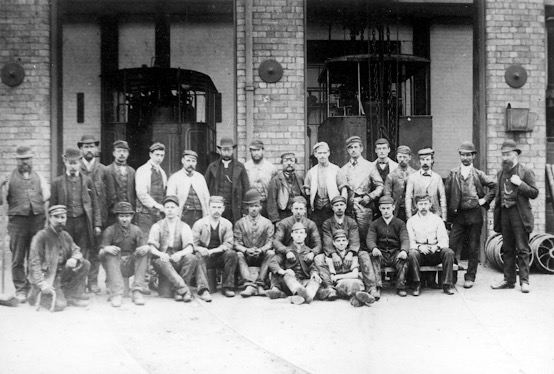
A very rare and early survivor, a photograph of an unidentified SS&BDTCo depot with the staff lined up for the occasion. It was purportedly taken in 1884, and there is absolutely no reason to think otherwise given the very clean brickwork (this was the Black Country after all). Photo courtesy of David Gladwin, with thanks to Trevor Preece.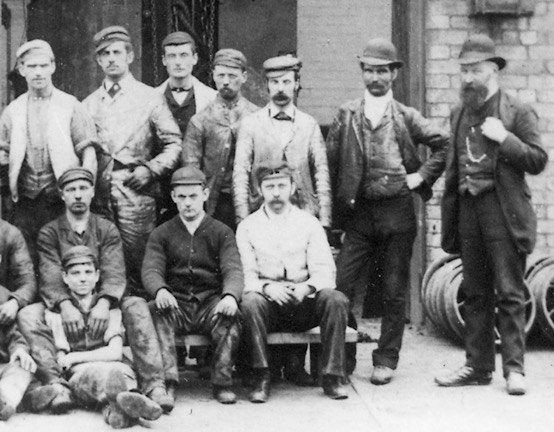
An enlargement of the above photograph showing a few of the staff. Whilst some are clearly fitters, the men at the back in tight-fitting caps a more than likely steam tram drivers; the man to the right may be a conductor or official.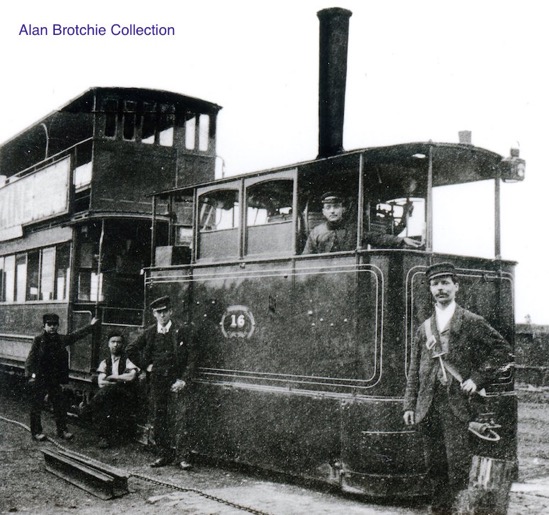
SSTCo No 16 (a Thomas Green product) stands with a Starbuck trailer in the depot yard at Darlaston — photo taken around 1888, so possibly still in SS&BDSTCo days. The conductor is wearing informal attire, without a cap badge.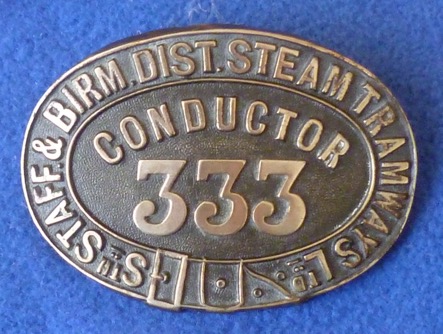
South Staffordshire and Birmingham District Steam Tramways conductor's cap badge — nickel. This badge is almost certainly a manufacturer's pattern book example, made for consideration by the company, but probably neither purchased nor issued. Clues are the repetitive, and very high, employee number, nearly three times higher than the entire staff of the company! Author's Collection.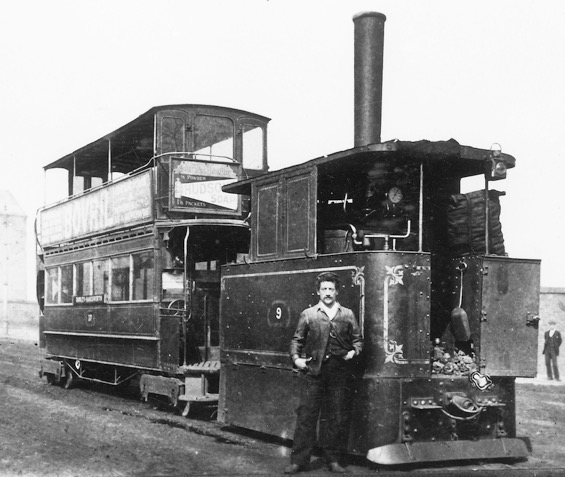
SSTCo No 9 (a Beyer Peacock engine) stands at Dudley Station with Trailer No 17 on a Dudley to Handsworth service — photo undated, but probably taken in the mid-to-late 1890s. Photo courtesy of D G Harvey, with thanks to Trevor Preece.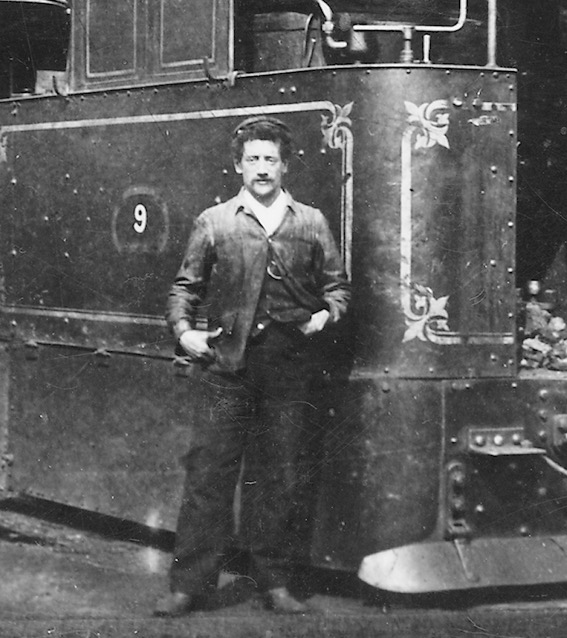
An enlargement of the above photograph showing the driver, whose clothing clearly betrays the filthy nature of his occupation.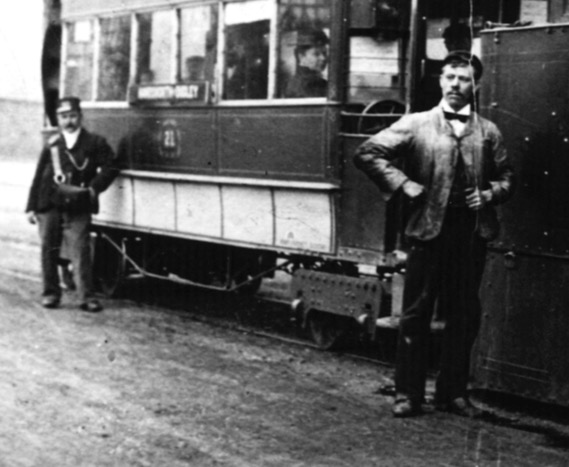
The driver of Beyer Peacock Steam Tram No 6 makes for a strange sight with his extremely grubby cotton dust jacket, contrasting starkly with his white wing-collared shirt and dickie bow. Although the conductor, leaning against the Falcon-built Trailer (No 21), appears to be wearing a cap with a cap badge, this is possibly just a trick of the light. The photo is unfortunately undated, but is likely to have been taken around the turn of the century, probably just prior to the South Staffordshire Tramways (Lessee) Company taking over operation. Photo courtesy of the Tramways and Light Railway Society, with thanks to David Voice.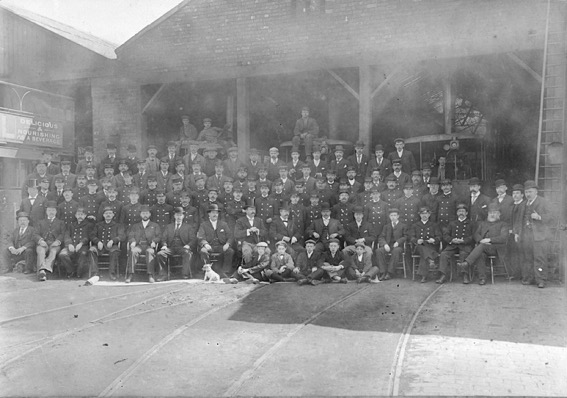
A superb photograph of an SSTCo depot, probably Darlaston, with all the staff lined up in brand-new uniforms, along with various top-hatted luminaries. The latter suggests that this was a special occasion, possibly following the take-over of steam services by the South Staffordshire Tramways (Lessee) Company in 1900. The photographer (Henri Gascon) appears to have been active in the area between 1895 and 1900. Author's Collection.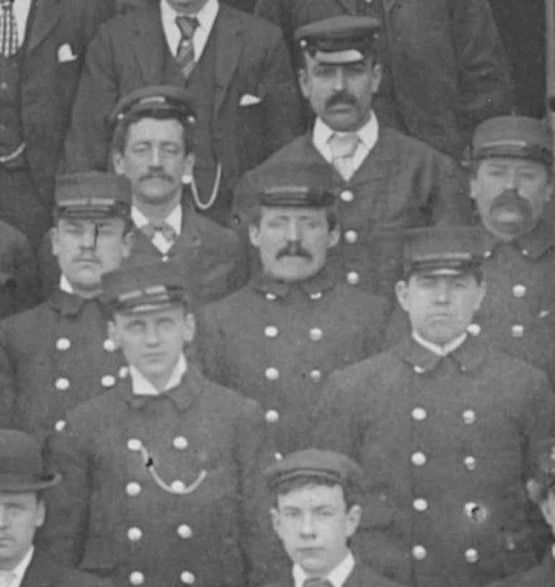
An enlargement of the above photograph showing five conductors, in double-breasted, three-quarter length coats and kepi-style caps (with pom pom), and two drivers, in single-breasted jackets with lapels and soft-topped peaked caps; neither of the cap types carries a cap badge. The driver pictured top left (with a dickie bow) bears a strong resemblance to the driver of Steam Tram No 9 (shown above), and may well be the same man.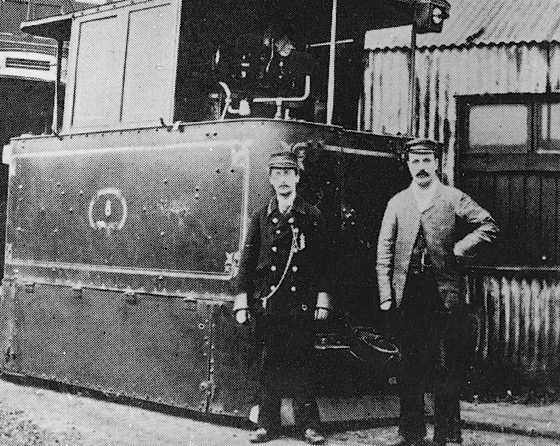
A conductor and a driver pose for the camera with Wilkinson Steam Tram 8 at Darlaston depot — photo undated, but probably taken around the turn of the century. Although the conductor is wearing the same style of uniform and cap as the depot photograph shown above, he appears to have a long badge on his right-hand jacket collar, very probably that pictured below. Author's Collection.
South Staffordshire Tramways (Lessee) Company collar badge — brass. This badge appears to have been worn from circa 1900, but only for a short period, perhaps until 1904. Author's Collection.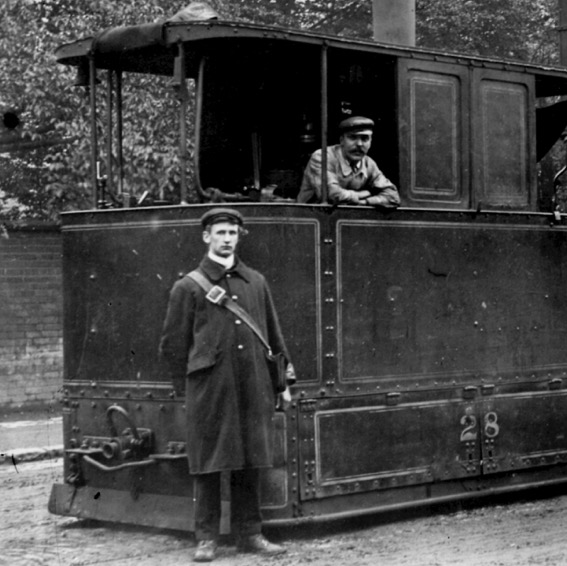
A conductor and a driver with Beyer Peacock Steam Tram No 28 in Tipton Road, Dudley — photo taken circa 1903, therefore in SST(L)Co days (though not shown, the trailer bears the BETCo 'Magnet & Wheel' device). The conductor appears to be wearing informal attire with a flat cap. Photo courtesy of the Tramways and Light Railway Society, with thanks to David Voice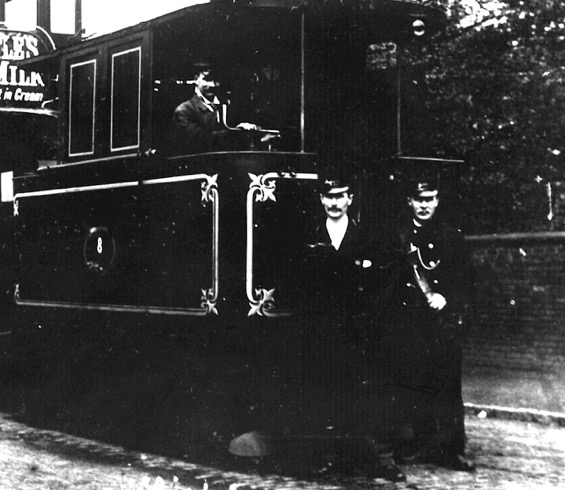
A rather poor photograph (contrast-wise) of Steam Tram No 8 and Trailer No 33, along with a number of staff, at Dudley Station on a Dudley to Handsworth service — photo undated, but probably taken around 1902/3. Both men in front of the engine are wearing caps, and what appear to be script-lettering grade badges. The individual on the left is an inspector (from his cap badge) whilst the man on the right, with cash bag, would appear to be the conductor. The presence of an inspector, as well as the photographer, may well hint at a special occasion, perhaps the last steam service? Photo courtesy of the Tramways and Light Railway Society, with thanks to David Voice.
Motormen and conductors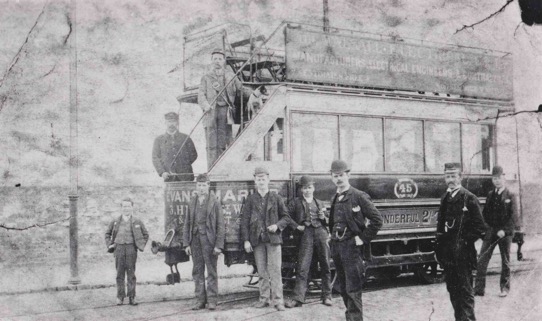
A rather pristine-looking Tramcar No 45, at an unknown location. Although the photograph is undated, the condition of the tramcar, coupled with the tall bowler hats with upturned brims, suggests that it was taken shortly after services commenced, i.e., 1893. Author's Collection.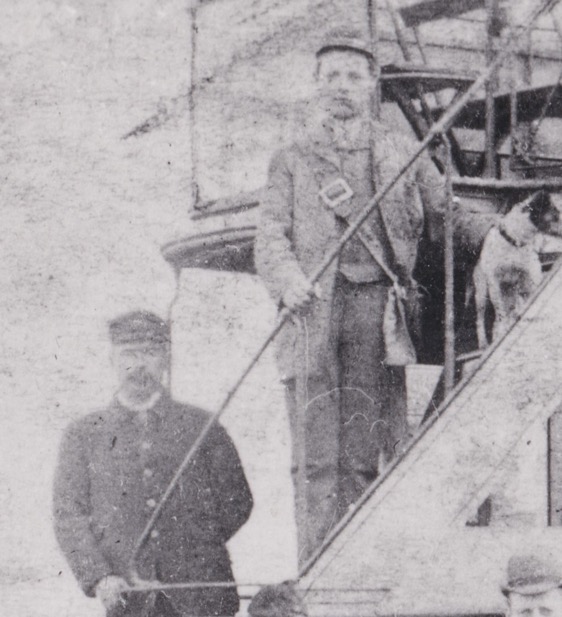
An enlargement of the above photograph showing the motorman (left) and conductor (right). The latter, who would have been an employee of SSTCo, appears to be wearing informal attire, whereas the former, who was possibly an employee of the Electric Construction Corporation, appears to be wearing a uniform jacket, along with a soft-topped peaked cap that possibly bears a cap badge.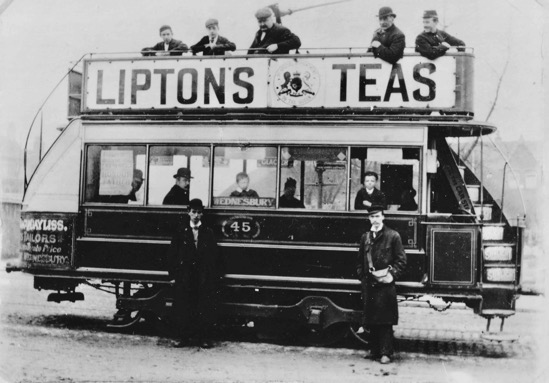
Tramcar No 45, once again at an unknown location — photo undated, but given the preponderance of flat caps, probably taken in the mid-to-late 1890s. Author's Collection.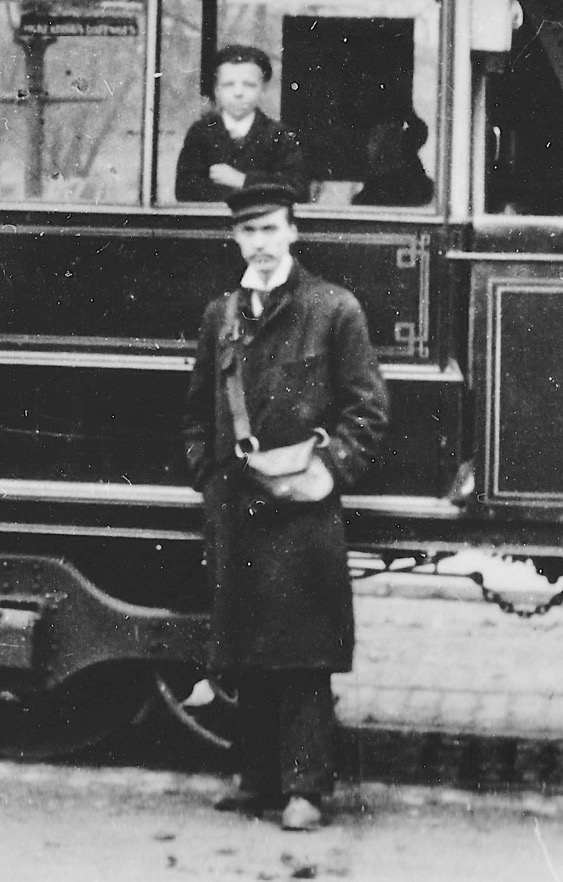
An enlargement of the above photograph showing the conductor. Like his colleague (see previous photo), who is presumably the motorman, he is wearing informal attire, no badges whatsoever being in evidence. 
Tramcar No 55 stands with its crew at Wednesbury (White Horse) — photo purportedly taken in 1899. Author's Collection.
An enlargement of the above photograph showing the motorman, W Morris. He is wearing a double-breasted jacket with embroidered 'B E T' company initials on both collars, and a kepi-style cap also bearing what would appear to be embroidered 'B E T' initials.
Another enlargement of the above photograph, this time showing the conductor. Although he is wearing the same style of jacket as his colleague (buttoned up rather than open at the neck), his collars are devoid of insignia. Rather than a kepi-style cap, he is wearing a drooping-peak cap, which bears what would appear to be a metal, script-lettering grade badge, 'Conductor'.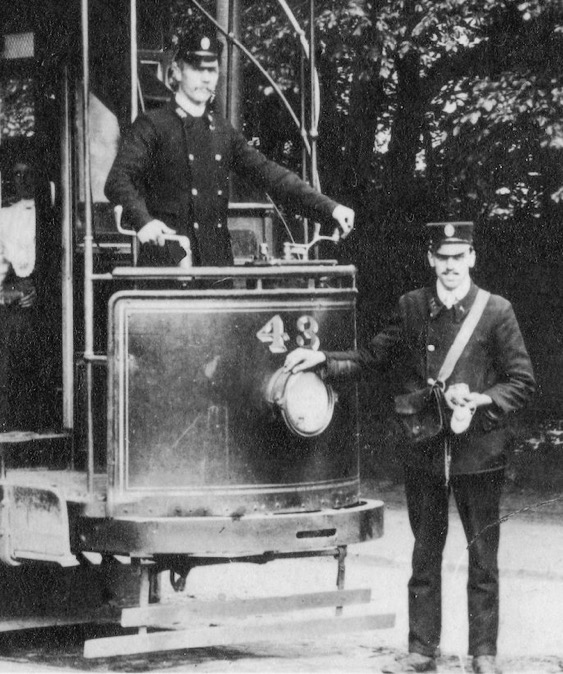
An SST(L)Co motorman and a conductor pose for posterity with Tramcar No 43 at the Tipton Road terminus in Dudley — photo thought to have been taken around 1912, i.e., in B&MTJC days. Both men are wearing double-breasted jackets, and drooping-peak caps bearing the standard B&MTJC cap badge. Author's Collection.
Birmingham and Midland Tramways Joint Committee cap badge — brass. This was introduced some time after 1904, when the South Staffordshire Tramways (Lessee) Co Ltd was placed under the control of the B&MTJC. Note the use of the British Electric Traction Company 'Magnet and Wheel' symbol, the BETCo controlling the B&MTJC and all its constituent tramway companies. Author's Collection.
Probable B&MTJC early rope-effect collar initials and collar number, which were eventually superseded by plain brass letters/numbers. Author's Collection.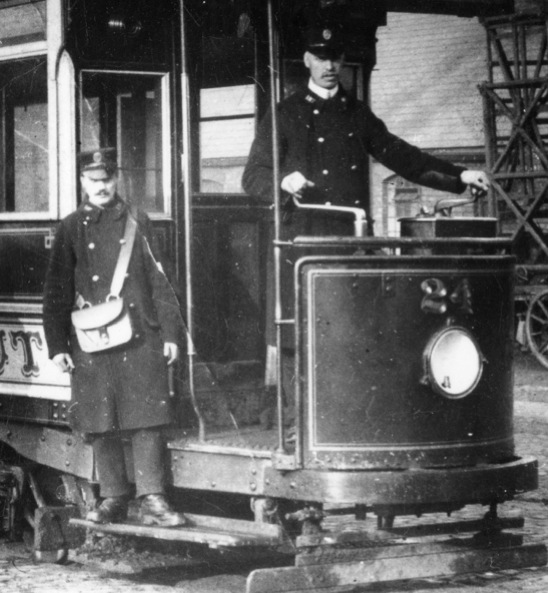
SST(L)Co Tramcar No 24 and crew — photo undated, but probably taken prior to the Great War (No 24 was cut down from its original double deck form around 1912). Author's Collection.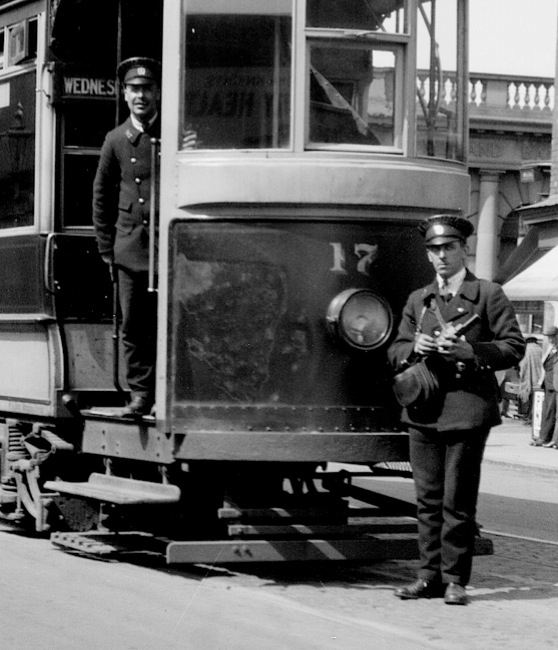
The crew of SST(L)Co Tramcar No 17 pose for the camera at Darlaston — photo undated, but probably taken in 1929, at which time these services would probably have been operated by the DS&DETCo. Photo by Dr H Nicol, courtesy of the National Tramway Museum.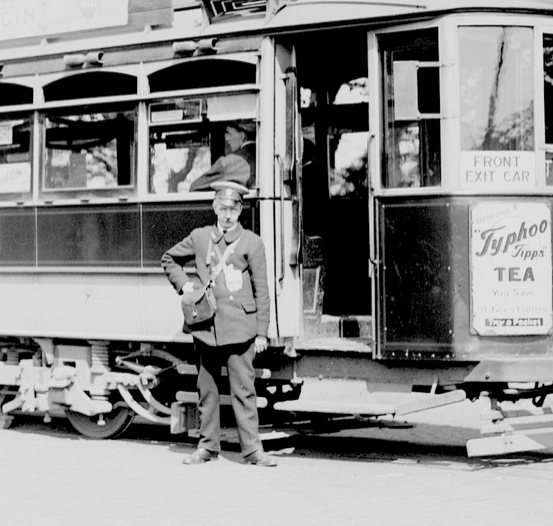
SST(L)Co Tramcar No 14 at the Tipton Road terminus in Dudley — photo undated, but very probably taken in the late 1920s. Photo by Dr H Nicol, courtesy of the National Tramway Museum.
Senior staff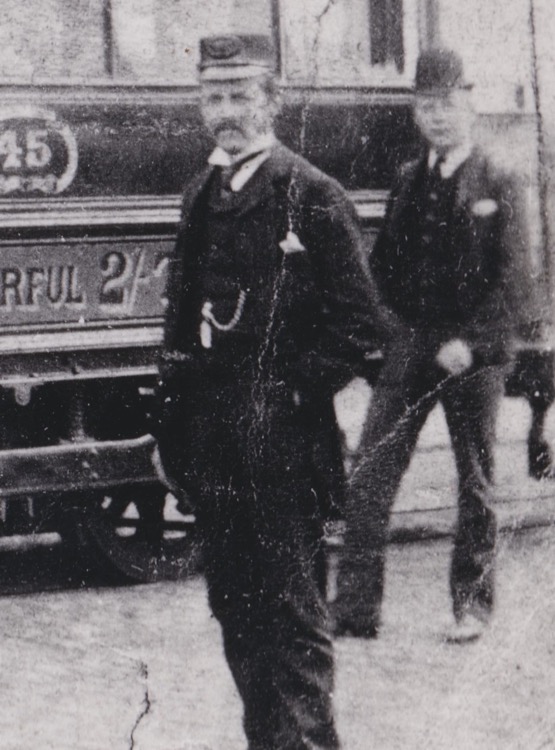
An enlargement of the photograph of Tramcar No 45 above, showing an individual who is in all probability, a South Staffordshire Tramways Company inspector. His drooping-peak cap bears a large oval cap badge, probably of embroidered cloth.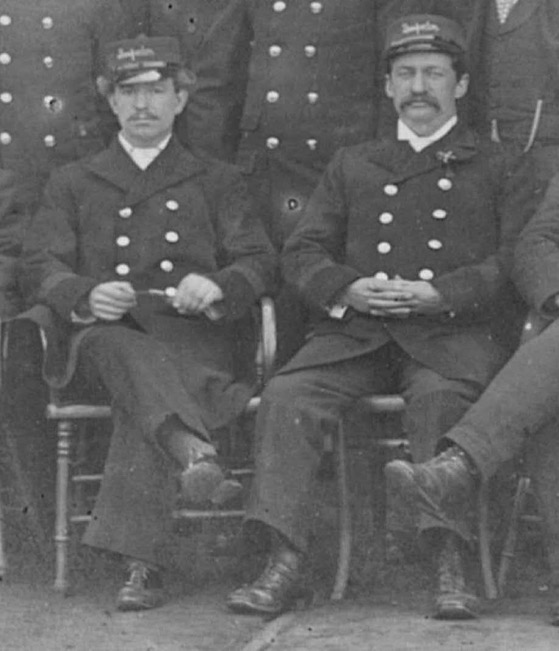
An enlargement of the 1895-1900 steam depot photograph above showing two of the inspectors. Both are wearing double-breasted, three-quarter length coats with lapels, along with drooping-peak caps topped with a pom pom; the caps bear a script-lettering grade badge — 'Inspector' — though it is unclear whether this was embroidered or metal.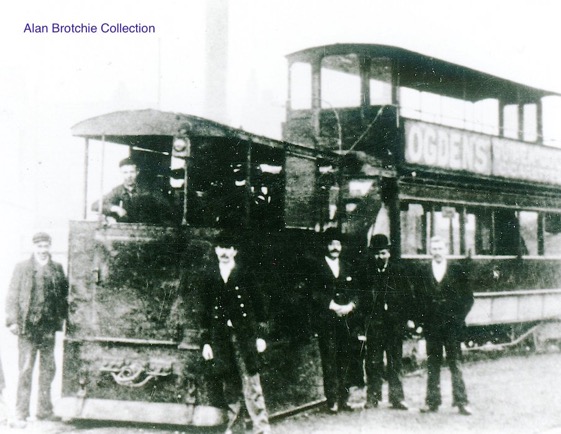
A really poor quality photograph, but one which in all probability shows a South Staffs inspector in steam tramway days. The location is supposedly Tipton and the date is probably the late 1890s. The inspector is the individual in the long, unbuttoned, double-breasted coat, in the centre of the shot.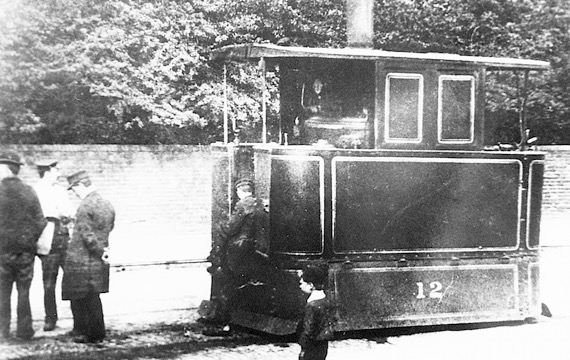
Another not particularly good quality photograph, but one which shows two inspectors, one third from the left, and the other on the front of No 12, a Beyer Peacock engine, both men in long coats and drooping-peak caps. The engine, pictured at Christ Church, High St, West Bromwich, is in post-1902 British Electric Traction Company livery, so the photograph must have been taken in that year, given that the line was converted to electric traction on the 19th December 1902. I am indebted to D G Harvey for this information. Photo courtesy of D G Harvey, with thanks to Trevor Preece.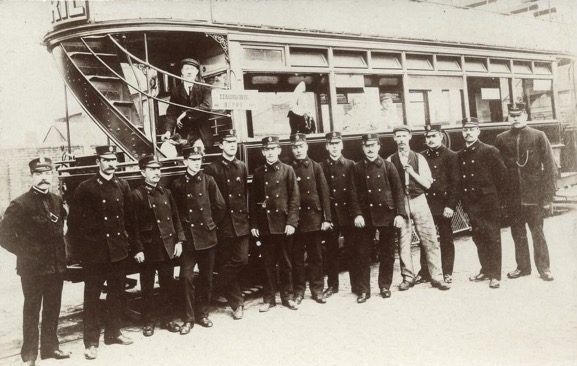
A line up of ten tramcar staff and two inspectors at Handsworth depot in 1907, i.e., during Birmingham and Midland Tramways Joint Committee days. Photo courtesy of the Stephen Howarth Collection.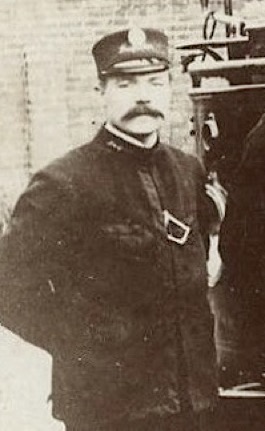
An enlargement of the above photograph showing one of the inspectors. His left-hand jacket collar appears to bear three embroidered initials, almost certainly 'B M T'. His other collar bore his grade 'Inspector' in embroidered script lettering. His drooping-peak cap bears the standard BMT cap badge and a grade badge, again probably embroidered.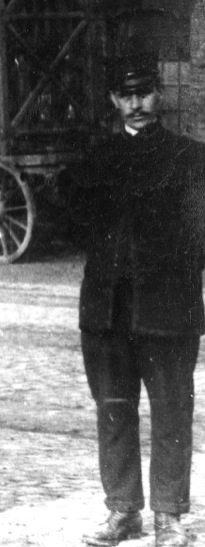
A B&MTJC inspector working on the South Staffs system, taken from the photograph of electric tramcar No 24 above — photo undated, but possibly taken just prior to the Great War. Author's Collection.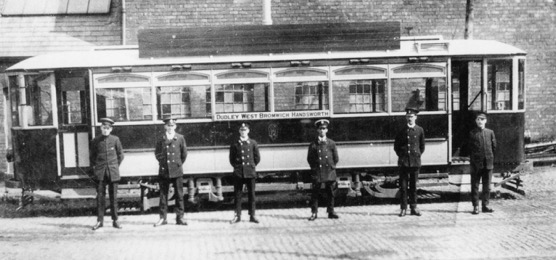
Two inspectors and four tramcar crewmen captured at Tividale Depot in 1920, in front of what may be one of the South Staffs Tividale-built single deckers. Author's Collection.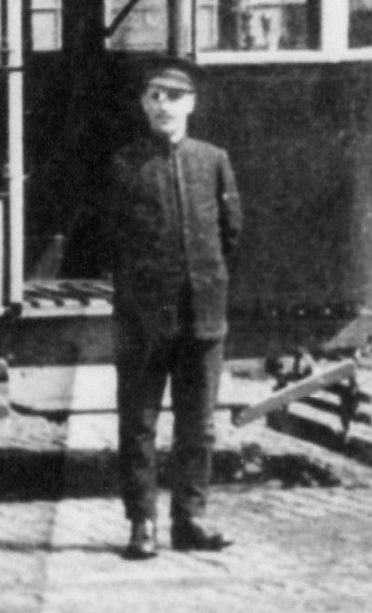
An enlargement of the above photograph showing one of the inspectors.
Female staff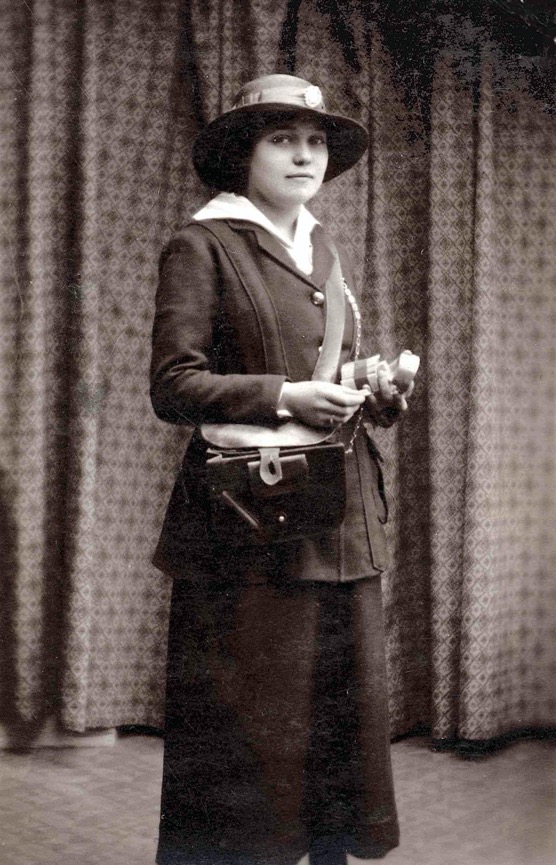
A rare studio portrait of a South Staffordshire Tramways (Lessee) Company conductress — photo undated, but probably taken around 1918 (at the Imperial Studio, 30 Bradford St, Walsall). Image courtesy of Dr Robert Frew.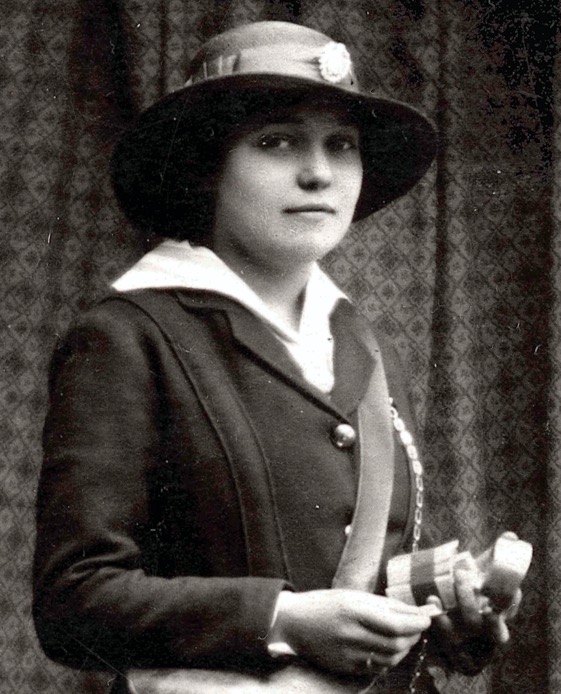
An enlargement of the above photograph showing details of the jacket, which bears BETCo 'Magnet & Wheel' buttons. The bonnet, which carries a standard BMTJC cap badge on a ribbon, would probably have been for summer wear only.